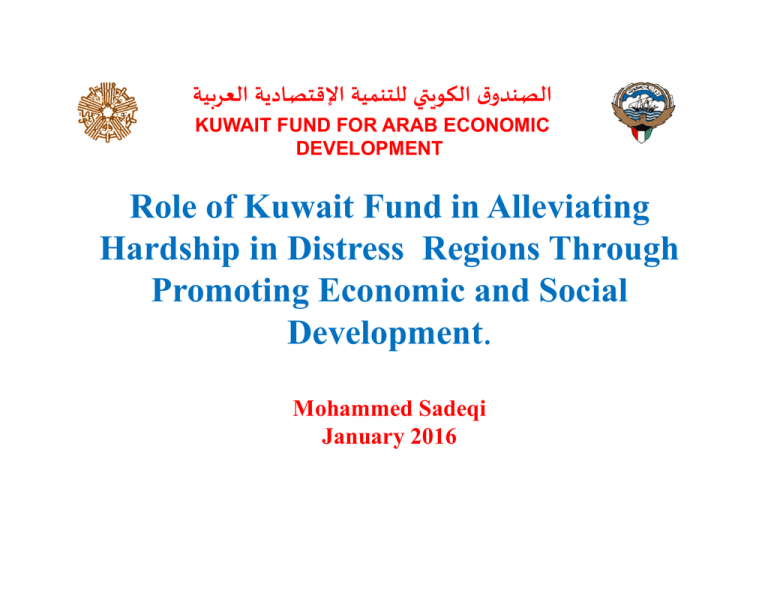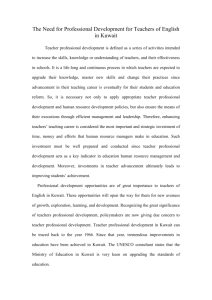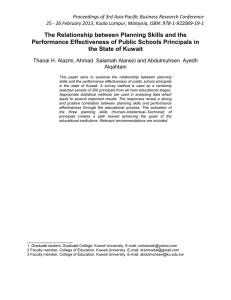Role of Kuwait Fund in Alleviating Promoting Economic and Social Development
advertisement

الصندوق الكوي للتنمية اإلقتصادية العربية KUWAIT FUND FOR ARAB ECONOMIC DEVELOPMENT Role of Kuwait Fund in Alleviating Hardship in Distress Regions Through Promoting Economic and Social Development Mohammed Sadeqi January 2016 Kuwait Fund Resources The State of Kuwait established Kuwait Fund for Arab Economic Development on 31st December 1961 to assist developing countries in their economic development. Kuwait Fund operations cover development projects that are financed by one of the following assets: 1. Kuwait Fund Loans: lending at concessional terms to finance projects, considered high priority by recipient countries. Approval of funding projects has been conditional on the outcome of well‐prepared feasibility studies, and the results of appraisal carried out by the Fund’s professional staff. 2. Kuwait Fund Grants and Technical Assistance: Kuwait Fund also extends technical assistance to help countries and institutions in capacity building to strengthen and accelerate their development efforts. 3. HIPC Initiative: Kuwait Fund supported the Heavy Indebted Poor Countries (HIPC) initiative, and has been providing debt relief to countries in accordance with the conditions for eligibility. 4. Grants from Government of Kuwait: Such grants are provided by Gov. of Kuwait in post‐conflict situations or countries in state of emergency faced with consequences of natural disasters. These Proceeds are normally administered and supervised by Kuwait Fund and are governed by Kuwait Fund procedures. 2 Kuwait Fund Assets Established on 31st December 1961. Initial capital : US $ 175 million. In 1974 the Fund extend scope of operation to include, in addition to Arab countries, other developing countries. The Fund’s capital increased in 1974 to US $ 3.5 Billion. In 1981 the Fund increases it’s capital to US $ 7.0 Billion. Today, the Fund’s Cumulative Commitment Reached US $ 18.7 Billion. 3 Kuwait Fund Guidelines and Procedures Kuwait Fund Operational Guidelines: The Fund’s operations for procurements of Goods and services, and disbursement are guided by flexible policies, simplified procedures, and transparent practices designed to spare recipients the burden of complicated and rigid operational guidelines. Monitoring and Supervising: Engaging Consultants to ensure the timely and orderly implementation of projects and the realization of their expected objectives and benefits. Co‐Financing Partners: Out of the 899 projects supported by Fund financing, nearly 57% by co‐financing arrangements to help recipients in mobilizing the resources required for the financing of major projects, and to insure their timely implementation. 4 Cumulative Loan Commitments (1962-2016) Kuwait Fund’s operations focuses on financing developmental projects in such sectors as agriculture, transport, telecom, energy, industry, water and sewerage and in health and education, with the aim of meeting the development objectives of recipients, including achieving the targets of the Millennium Development Goals (2000-2015). Period Total Loan Commitments (Million US$) Total No. of Loans Total No. of Countries 1962-1975 869.4 66 18 1962-1982 3,727.2 235 55 1962-1990 5,922.8 384 64 1962-Present 18,719.5 899 105 In January 2016, the total loan commitments reached US$ 18.7 Billion, with 899 loans and 105 recipient countries. 5 Loans Geographical Distribution In the end of 2015, the number of loans increased to reach 899 of which 56% for projects in Arab countries and 18% for South , East Asia & Pacific countries, 17% for African countries, 6% Central Asia & Europe and 3% Latin America & the Caribbean countries. Latin America & the Carib 3% Central Asia & Europe 6% South , East & Pacific 18% Arab Countries 56% African Countries 17% 6 Sectorial Distribution The pattern of distribution of projects reflects the importance and priority accorded by recipient Governments to projects in various sectors. All such projects were screened on the basis of the feasibility studies submitted to the Fund, and were thoroughly appraised by it to confirm their technical soundness and their financial and economic viability. Telecom 2% Social Development Banks 5% 2% Water and Sewage 11% Miscellaneous 1% Transportation 34% Energy 27% Industry 7% 7 Agriculture 11% Status of Kuwait Fund Loan and Gov. Grants as of 17/1/2016 Source of Financing Fund Loans Gov. Grants KF TA & Grants Number of Loans 899 76 260 Number of Beneficiaries 105 43 115 Total Loan Amount (MUSD) 18,720 5,490 765 Withdrawals (MUSD) 14,781 3,277 341 Undisbursed (MUSD) 3,939 2,213 424 (%) Withdrawals from Total 80% 60% 45% Disbursements from Kuwait Fund loan and Gov. of Kuwait rants equivalent to about 80% of total loans, 60% of total grants committed and 45% of total Kuwait Fund technical Assistance & Grants. 8 Advanced Technology and development Kuwait Fund operations relies on the latest technologies to provide the needed geographical and sectorial distribution of its assistance and to insure efficient and timely implementation of its funded projects, in addition to those projects in post‐conflict situations or countries in state of emergency that are faced with consequences of natural disasters such as earthquakes, floods, and extreme drought . Modern telecommunication, including access to mobile phones, computers, mass media and internet based technologies such social media and communication , advance Instrumentation and control are all tools that contribute toward improving project preparation, reducing implementation period, reducing project cost and improving project out‐puts. 9 Impact of Technology on implementation and Operation of Kuwait Fund Projects 1. Reduced decision‐making time on projects through timely preparation of detailed studies. 2. Improve coordination between the Fund and recipients and between the Fund and Co‐Financiers. 3. Improve banking services so that disbursement on projects are improved. 4. Reduce volume of documents by replacing hardcopies with electronic soft documents. 5. Accurate and precise data generation on natural resources such as water, hydrocarbons, and minerals. 6. Increase efficiency of Utility plants(electricity, water and sewerage) through advance Instrumentation and control (improve return on investments). 7. Improve monitoring, control and supervision of project implementation. 8. Up‐grading operational management of sectors through modernizing Institutional. 10 Concluding Remarks • • • • • The contributions by the State of Kuwait through Kuwait Fund has demonstrated that people, without distinctions of their race, religion and nationalities, have the right for a dignified life. Supporting Distressed Countries by financing economic and social developmental projects contributes to alleviating poverty and hardship, thus averting anarchy and violence. It is vital to work with Co‐financing partners to develop guidelines for assessing economic and social impacts related to post‐conflicts and natural disasters. The challenges associated with timely and orderly implementation of developmental projects can not be achieved without good preparation, project management, monitoring and control. Advanced technologies are positively contributing in meeting the challenges associated with realization of developmental benefits and objectives, especially in post‐conflict regions or countries suffering the consequences of natural disasters. 11





